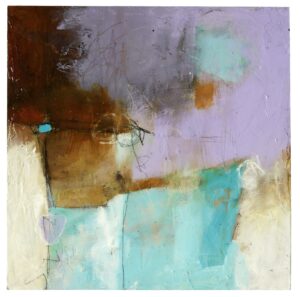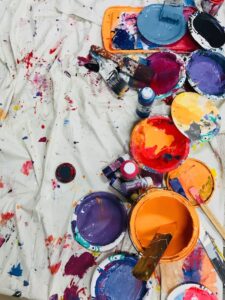Painting and finishing have made amazing strides in modern times. There are now a lot of creative possibilities! This article is all about the most up-to-date trends in painting and finishing.
Artists are using unexpected materials like metal, glass, and even recycled items in their work. It adds a unique look and challenges what we think of when we think of painting.
As well, new digital technology has made it possible to create digital art that is just as amazing as traditional art. This is giving artists more scope for creativity and experimentation.
Traditional painting methods like oil painting and watercolors still have lots of fans. People still appreciate the classic styles!
This article was inspired by ‘Art Now: Modern Trends in Contemporary Painting‘ by Susan Bright. It gives us a great look at the ever-changing painting and finishing world.
History of Painting and Finishing Techniques
Painting and finishing techniques have ancient roots. From early humans’ cave paintings to Renaissance Italy’s grand frescoes, art has changed over time. Advances in tools and materials, plus changes in styles, have driven the evolution.
In the past, ochre and charcoal were used to make vivid colors. As cultures advanced, oil and watercolor allowed more realism. During the Renaissance, painters like Leonardo da Vinci and Michelangelo perfected light and shadow effects with chiaroscuro. This technique left a lasting influence on artists.
Impressionism and Expressionism in recent decades have pushed painting boundaries. Monet and van Gogh used loose brushwork and strong hues to capture emotion and moments. Digital art tools now allow intricate designs with ease. Sprays and acrylic give new textures and applications.
A paint palette 100,000 years old was found in South Africa’s Blombos Cave. It was made from ochre pigments used for body painting and rock art. As painting and finishing techniques head into the future, technology and creativity will guide them. Artists will find new ways to show their work on canvas or screen.
Modern Trends in Painting and Finishing Techniques
Recent years have seen groundbreaking developments in painting and finishing techniques. Creative methods and tools have been embraced, allowing for a new level of artistry and exactness.
High-tech materials and tools have been used to craft impeccable results. Advanced paint coatings now offer greater durability and fewer signs of wear. Eco-friendly paints are also becoming increasingly popular, as people strive to reduce their environmental impact.
Technology has infiltrated the painting process. Artists have access to digital tools that let them try out different colors and textures, before applying them to surfaces. Digital imaging techniques make intricate patterns and designs easier to achieve.
Unconventional materials have been explored in painting and finishing. Metal, glass, and even recycled objects are used to add texture and depth to artwork. This experimentation leads to surprising, unique pieces.
Jackson Pollock’s “drip painting” technique is a noteworthy example of modern painting trends. Pollock poured or dripped paint onto a canvas placed on the floor, giving him endless freedom in his movements. This technique redefined abstract expressionism and continues to inspire today.
It is clear that modern trends in painting and finishing will continue to shape this timeless art form. Artists are embracing these advances, pushing boundaries, and creating mesmerizing masterpieces.
Advancements in Technology and Tools
Tech and tools have revolutionized painting and finishing techniques. From superior equipment to inventive materials, these advancements have increased painters’ craftsmanship and productivity. Let’s look at some significant improvements in this ever-shifting area.
High-volume low-pressure (HVLP) sprayers are a major advancement. They give painters a perfect finish with minimal overspray, thus decreasing material wastage. Furthermore, their exceptional atomization capabilities make HVLP sprayers favoured by professionals for precision in their work.
Electrostatic paint spraying systems are also revolutionizing the industry. By using electrically charged particles, they offer an even distribution of paint on surfaces, reducing wastage and producing consistent results. Additionally, they help painters work efficiently while complying with environmental regulations by reducing airborne pollutants.
Automated color matching technology is another remarkable transformation. With a quick scan or a color code input, it can accurately recognize and reproduce any shade. This time-saving innovation does away with manual mixing and minimizes mistakes, giving painters control over their color choices.
Pro Tip: Use tech advancements but always remember practice is essential for exceptional results.
Case Studies: Examples of Innovative Painting and Finishing Techniques
Painting and finishing have evolved! Innovative methods have created captivating results. Case studies showcase modern trends.
Gradient Painting: Specialized airbrushes create smooth color transitions. This adds depth to artwork.
Metallic Finishes: Metallic pigments in paint create a shimmering effect. It catches the light.
Graffiti Art: From street walls to art galleries, spray paints and stencils are used to create intricate designs.
These techniques can help set projects apart. Consider combining different techniques or experimenting with unconventional materials.
Pro Tip: Plan and practice before committing to a final piece. Experimentation is key to mastering painting and finishing.
Benefits of Modern Painting and Finishing Techniques
Modern painting and finishing techniques have transformed the way art is approached. These methods bring many advantages. Here are six of them:
- Durability: Modern techniques provide a protective layer, so the painted surface can last longer.
- Aesthetics: Painters can create stunning visuals that captivate viewers.
- Faster Application: Technology allows quicker application, saving time.
- Environmentally Friendly: Low-VOC content reduces emissions and promotes health.
- Versatility: Options to explore styles, textures, and patterns.
- Easier Maintenance: Sealants and coatings make cleaning and maintenance simpler.
The world of modern painting is constantly changing. Artists experiment with materials and methods to create art. It is important to stay informed of emerging trends. Jackson Pollock pioneered “drip painting,” which involved dripping paint onto a canvas on the floor.
Challenges and Considerations
Modern painting and finishing techniques come with plenty of challenges and considerations. To tackle them, expertise and attention is a must! This includes:
- Application Methods: Pick the right brushing, rolling or spraying technique for the surface of your project.
- Material Selection: Get the right paint/finish that suits the surface and environment.
- Achieving Desired Finishes: Create matte, glossy, textured or metallic effects with appropriate painting techniques.
Safety is also key. Wear protective gear like goggles and masks when handling volatile paints and finishes.
Stay informed about trends in the industry too. This will not only make you a better painter but can also lead to amazing opportunities.
So, be daring and go for it! With enthusiasm and an eye for new trends, you can reach new heights in painting and finishing.
Conclusion: The Future of Painting and Finishing Techniques
The potential for innovation in painting and finishing techniques is immense. New methods are emerging all the time, to give artists and craftsmen more ways to express themselves. From 3D printing to digital painting, the possibilities are endless.
Eco-friendly practices are becoming increasingly popular. Natural pigments derived from plants and minerals can offer vibrant colors while reducing the use of harmful chemicals.
Mixed media is also gaining traction. Combining paint, photography, collage and sculpture, artworks can become multidimensional and engaging.
Digital art installations and interactive exhibits can give viewers an immersive experience. VR technology has enabled artists to create whole worlds that blur reality and imagination.
Modernism significantly impacted painting and finishing techniques. Abstract art challenged traditional notions of representation, paving the way for new forms of expression. Pioneering artists like Kandinsky and Mondrian explored color, shape and line as independent entities.
Technology, eco-friendly practices, mixed media, and inspiration from history – these are the building blocks for the future of painting and finishing techniques. This is an exciting time for artists. The future beckons, inviting us on a journey of exploration and discovery.
Frequently Asked Questions
FAQ 1:
Question: What are some popular modern trends in painting and finishing techniques?
Answer: Some popular modern trends in painting and finishing techniques include textured paint finishes, metallic accents, color blocking, faux finishes, and distressed or vintage-inspired looks.
FAQ 2:
Question: How can I achieve a textured paint finish?
Answer: To achieve a textured paint finish, you can use techniques such as sponge painting, stippling, or rag rolling. These methods create depth and texture on the painted surface.
FAQ 3:
Question: What are metallic accents in painting?
Answer: Metallic accents involve using metallic paints or foils to add shimmer and shine to a painted surface. This technique is great for creating a modern and luxurious look.
FAQ 4:
Question: What is color blocking in painting?
Answer: Color blocking is a technique where different bold and contrasting colors are used to create geometric or abstract shapes on a painted surface. It adds a contemporary and artistic touch to the design.
FAQ 5:
Question: What are faux finishes?
Answer: Faux finishes involve using paint or other materials to imitate the appearance of another material, such as wood grain, marble, or stone. This technique allows you to achieve an expensive look without the actual material’s cost.
FAQ 6:
Question: How can I create a distressed or vintage-inspired look on furniture?
Answer: To create a distressed or vintage-inspired look on furniture, you can use techniques like sanding, whitewashing, or adding a crackle glaze. These techniques give furniture an aged and weathered appearance.



